Hi Everyone.
It’s been a wild month for getting myself into trouble. Maybe not trouble exactly, but it seems that inadvertently, I did stir up some contentious conversations. My video on why I hate Dry January garnered a lot of support—and also caused a lot of anger. One person posted on my Instagram page that I should “re-evaluate my relationship with alcohol.” For the record, I think I’m fine.
But I’m sad that the person who posted thinks it’s his, or anyone’s, right to tell another person whether or not and when to drink wine. And I’m sad that two whole months are now guilt-trippingly institutionalized to make us feel we are doing something wrong, bad, even unethical, by drinking wine. Dry January and coming up: Sober October.
And as if those aren’t sobering enough, there’s also the new World Health Organization’s guideline that says no amount of alcohol—none—is safe.
I am all for individual choice. I believe we should all make our own decisions regarding our bodies and our health. But I also continue to wish that more people and more organizations would tell the other side of the story—the side that talks about the positive role wine has played in history, culture, community, and a healthful lifestyle.
That’s the part of the story I want to continue to tell.
Also this month, I announced in WineSpeed and on social media that I would no longer write about wines that come in massively heavy bottles—what one reader calls “the wine bottle equivalent of a Hummer.” (Here’s that video if you missed it). These are bottles—we’ve all seen them and felt them—that weight about 4 ½ pounds or more when full (a “normal” bottle of wine when full weighs about 3 to 3 ½ pounds).
It was not a hard decision to take. As much as 40% of a winery’s carbon footprint comes from transporting glass bottles. Every winery I know of talks about sustainability, protecting the environment, and farming their vineyards in a way that preserves the integrity of the land, that preserves their terroir. How can that winery—seemingly so committed to nature—be tone deaf when it comes to the carbon impact of massive glass bottles? It makes no sense.
In the 1980s and 1990s many wineries believed we consumers were impressed by big bottles; the bigger the better. Now? Now we live in climatic chaos. Wineries can’t just talk the talk of sustainability; it’s time to walk the walk. Those giant bottles need to go. Besides, it’s the wine inside that counts.
Since I appear to be getting stuff out of my system, there’s one more topic I’d like to bring up: rosé wines bottled in clear glass. Rosé samples are already rolling into our offices, as they do every spring. And so far, all but one have been bottled in clear glass.
Rosé producers use clear glass because they believe your decision to buy (or not) will be based largely on the wine’s pretty pink color. Maybe they are right about that. But here’s the problem (and wineries know it): Wine inside clear glass bottles is highly prone to lightstrike, a fault that occurs when a bottle of wine is exposed to light for a prolonged period. Wines bottled in clear glass bottles—like many rosés and sparkling wines—are especially prone to lightstrike. (Darker glass blocks some of the harmful wavelengths).
Lightstruck wines have an off aroma and flavor often compared to boiled cabbage or stagnant drain water. Because of the intensity of its UV light, sunlight is the worst culprit; fluorescent and LED light is not as damaging as quickly. Lightstrike can happen to wines bottled in clear glass after just a few days of intense exposure.
Last year, I’d say 20% of the rosés we tasted suffered from lightstrike.
Is there any way to know before you buy a bottle of rosé? Unfortunately, no. But in a wine store, I’d definitely avoid a floor stack of rosés near a sunny front window.
And I’d avoid drinking Cabernet with chocolate too (that video is coming for Valentine’s Day).
Okay, enough carping. Turning to things more wonderful:
It’s raining here in the Napa Valley where I live. Not typical Napa Valley rain which sounds like gently tapped keys on a piano. No. The atmospheric rivers swarming in the skies above Napa have dropped New York style rain on us: hard, powerful, unrelenting. Dangerously beautiful rain that has turned the still-dormant vineyards to chocolate-colored mud. Everyone is gleefully happy. I suppose we all imagine the swollen belly of earth below us holding all that water; saving it for when the bone-dry summer comes.
Rain puts me in the mood to drink Pinot Noir (and I believe that wine should be matched to mood—more so than to food). And so it was that I found myself thinking about Pinot Noir the other day. It occurred to me that, despite all my Pinot musings, I rarely think about red Burgundy anymore. It was kind of shocking. When I began writing about wine, Burgundy was the mother ship. Pinot Noir was Burgundy. Period.
Now I see in my mind’s eye a long sleek red triangle formed by Sta. Rita Hills in southern California, the far West Sonoma Coast in mid-northern California, and the Willamette Valley in Oregon. As long as I can drink Pinot Noir from these three extraordinary places I will always be happy.
Recently, in WineSpeed, I wrote about Domaine Drouhin’s Pinot Noir called “Laurene” made in the Willamette. It was, I said, like someone putting their cool hand on your warm skin. The capacity for Pinot Noir to be sensual…my god, there’s just no limit. Here’s the review.
Lastly, I just came back from Chile where I visited Eduardo Chadwick’s estates and did vertical tastings of Don Maximiano, Pizarra, Seña, and Vinedos Chadwick. There were ten of us from around the world. Four Masters of Wine; one Master Sommelier; and several journalists all of whom had written pivotal books. It was heavy company. The unspoken mental competition was severe. The wines were fantastic (I’ll write more about them soon). And as you can see from these photos, we were all VERY serious throughout the entire trip.
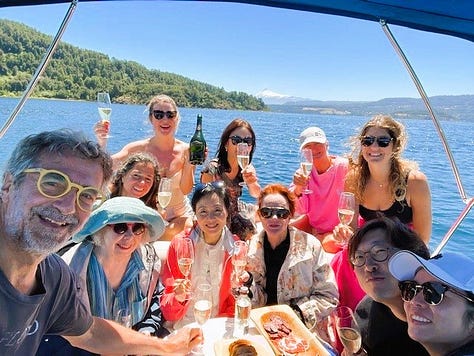
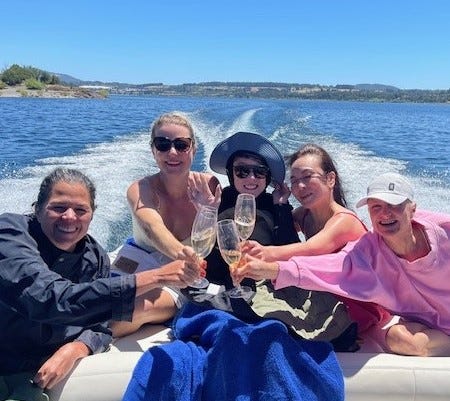
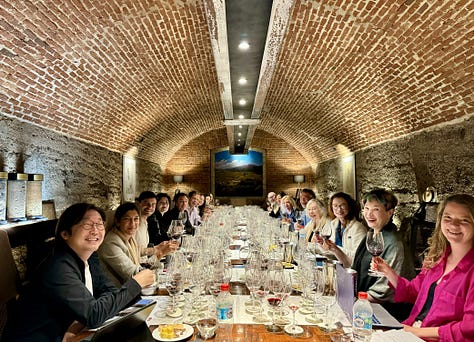
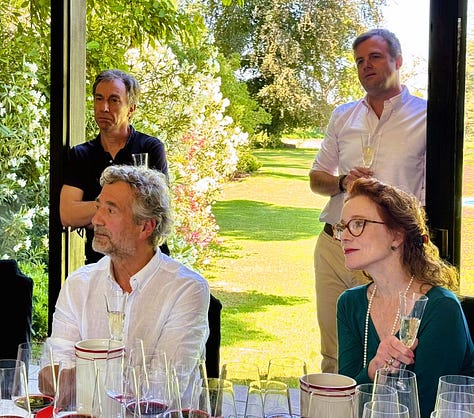
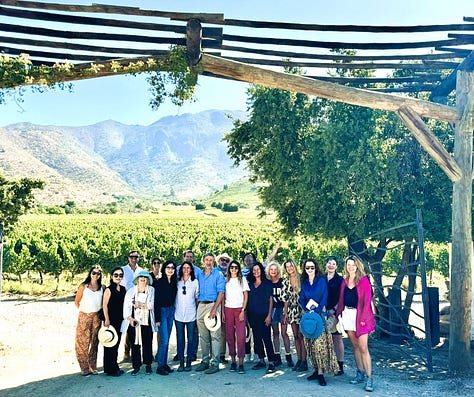
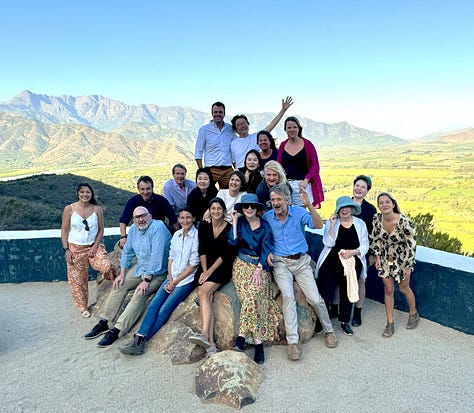
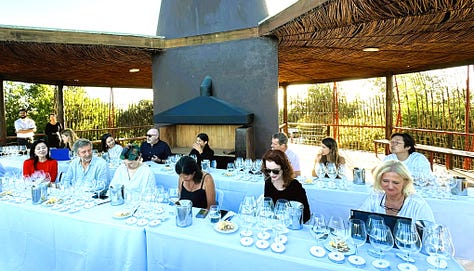
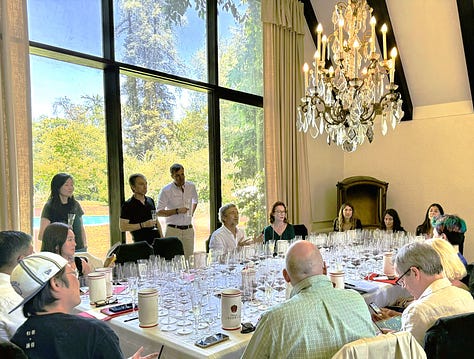
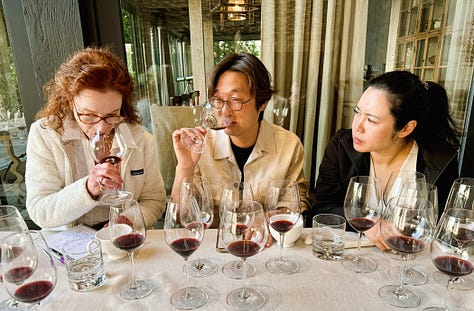
—Karen
PS: Here are three super fun wine events you might like to attend:
Wine Road Sonoma County Barrel Tasting 2024




I really agree with you about Dry January and. Sober October. I am 85 and have a glass of wine, preferably red, every day. My yearly physicals say that every thing is working fine. So I can only pity the poor people that think they need to stop enjoying wine for two months.
I agree about dry January too, simply because moderation across the year works better than binging in December and February. Plus, January is cold and I need wine for that...